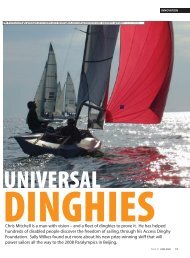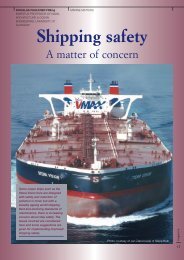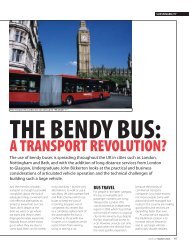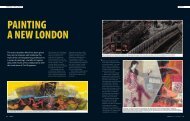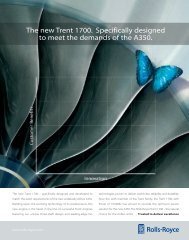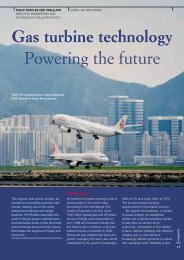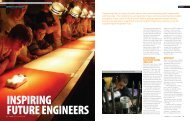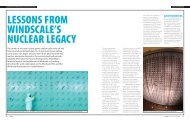[322/03] Francke - Ingenia
[322/03] Francke - Ingenia
[322/03] Francke - Ingenia
You also want an ePaper? Increase the reach of your titles
YUMPU automatically turns print PDFs into web optimized ePapers that Google loves.
INFRASTRUCTURE<br />
ingenia<br />
26<br />
Figure 4: Aerial view of tunnel section being towed to site<br />
The immersed tunnel was<br />
constructed from twenty prefabricated<br />
concrete tunnel elements. The elements<br />
were cast at a purpose-built factory 12<br />
km north of the tunnel site. Each<br />
element was towed to the tunnel site by<br />
four tug boats and lowered into the<br />
tunnel trench with enormous precision,<br />
using GPS satellite navigation.<br />
The fact that casting took place<br />
under cover allowed for efficient and<br />
smooth production, regardless of the<br />
weather. As a positive side effect the<br />
number of work-related accidents was<br />
subsequently reduced.<br />
Each tunnel element is 176 metres<br />
long, 49 metres wide, approximately 9<br />
metres high and weighs around 57,000<br />
tonnes. Each element was cast in eight<br />
sections at the tunnel factory each of<br />
which was cast in one 30 hour cycle.<br />
Each section was cast against the<br />
previous section and the element was<br />
then gradually pushed out of the<br />
casting hall and on to a ramp, in what<br />
was, in effect, a giant lock system.<br />
When all eight sections were cast and<br />
one complete 176 metre element was<br />
ready, a sliding gate was closed behind<br />
the element, and the basin was flooded<br />
until the element floated.<br />
The element could then be pulled<br />
into the deep end of the basin to await<br />
being towed to the tunnel site. After the<br />
water inside the lock had reached sea<br />
level allowing the element to be towed<br />
out, the next two elements would be<br />
cast. Two parallel production lines<br />
allowed for maximum output and<br />
efficiency.<br />
The towing of the elements<br />
demanded great skill and precision. The<br />
57,000 tonne element was almost<br />
completely immersed during towing<br />
and the changing currents in Øresund<br />
had to be calculated in great detail<br />
before the towing-out. This operation<br />
took place in the Drogden Channel in<br />
Western Øresund, which is an<br />
international shipping route used by<br />
some 40,000 ships per year. Early in<br />
the construction phase a radar station<br />
was established to monitor shipping<br />
and guide vessels through the work<br />
areas thus avoiding any major<br />
accidents. During operations only a<br />
handful of collisions and minor incidents<br />
took place involving work vessels and<br />
shipping, causing material damage only.<br />
Not once was a tunnel element<br />
damaged due to a collision. However,<br />
on 4 August 1998, the accident that<br />
everybody was dreading took place: a<br />
tunnel element was flooded while being<br />
positioned in the tunnel trench. Before<br />
tow-out the tunnel tubes in the element<br />
were sealed off with steel bulkheads.<br />
Due to a number of mistakes one<br />
bulkhead was not properly secured and<br />
succumbed to the water pressure. In a<br />
matter of seconds all five tunnel tubes<br />
in the large concrete element filled with<br />
water, and in accordance with<br />
procedures the element was<br />
immediately lowered into the trench,<br />
but several metres out of position. It<br />
took Øresund Tunnel Contractors eight<br />
weeks to inspect, repair and eventually<br />
move the tunnel element into its correct<br />
position.<br />
During this period the lowering gear<br />
and platforms were attached to the<br />
flooded element so the contractor was<br />
unable to save time simply by building<br />
the tunnel from both sides at the same<br />
time. However the tunnel factory<br />
continued to produce the tunnel<br />
elements and once the flooded tunnel<br />
element had been repaired and placed<br />
in the correct position, the tow-out and<br />
construction of the rest of the tunnel<br />
elements was carried out at high<br />
speed. As a result, despite this major<br />
setback, the tunnel was constructed<br />
ahead of schedule.<br />
The Bridge<br />
For the bridge section, which connects<br />
the artificial island with the Swedish<br />
coast at Lernacken, a cable-stay<br />
design was chosen for the high bridge<br />
due to the weight of the combined<br />
railway and motorway link. The entire<br />
bridge is 7.8 km long of which the high<br />
bridge accounts for 1,092 metres. The


![[322/03] Francke - Ingenia](https://img.yumpu.com/23411337/4/500x640/322-03-francke-ingenia.jpg)
